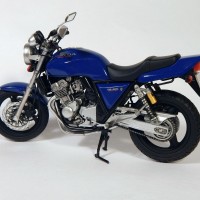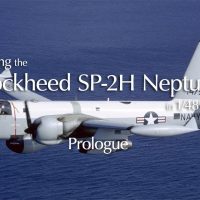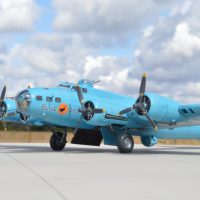The ‘rocket with a pilot’, well, ‘with two pilots’, in this case! TF-104G Starfighter, Aeronautica Militare
As a small preface:
This model was created as a farewell gift for a long-time acquaintance: he is the owner of the penultimate pure modelling shop in my home town. He will be retiring in the foreseeable future and his modelling shop will be closing its doors for good. I have to admit to a little melancholy, because the name of this shop has had a special ring to it since my youth and over the years it has often been a place of longing visits, relaxed browsing, happy purchases and, of course, good conversations.
The fact that this will soon come to an end illustrates a development that is neither new nor unnoticed, because the world of scale modelling has changed enormously in those years! This applies not only to the type of sales and private purchasing, but also to the incredible range of products on offer, as well as to the quality on offer and the demands that have risen in line with this. The channels of exchange and communication have also expanded in a truly unimaginable way thanks to global digital networking. So even if much seems lost, we have also become richer in some things that we no longer want to do without. But who knows, perhaps in the future there will be ways in which the best of the digital and analogue worlds of model making can be combined to create something new? Modelling is always a child of its time - a basically positive thought, which I would like to end with Wilhelm Busch's lovely words ‘One, two, three, time rushes by, we rush along...'.
About the TF-104G
The F-104 Starfighter is also a child of its time. First flown in 1954, the F-104 quickly became known for being the fastest fighter aircraft in the West: the ‘manned missile' reached 2259 km/h in a record attempt in May 1958. However, technical difficulties and a slow start to deliveries meant that other ‘century-series' designs such as the F-101 or the F-106 were able to overtake the F-104: the USAF procured fewer examples than originally planned, so Lockheed had to look for new markets for the super fighter.
At the end of the 1950s, a generational change was overdue in the NATO air forces of Europe. The German Air Force proved to be the driving force: here, the F-84 Thunderjet had clearly reached the end of its operational capability. Lockheed's campaign for a successor model fell on fertile ground after corresponding lobbying activities: a variant optimised for European conditions, known as the F-104G (G for Germany), was intended to expand the air force's nuclear capabilities in particular as a low and fast-flying nuclear weapon carrier. In addition to structural reinforcements to the airframe, the new Starfighter variant was equipped with a powerful Autonetics NASARR F15A-41B fire control radar and the Litton LN-3 navigation system Weapons computers, the autopilot and the engine were also upgraded: the latter was converted to the high-thrust J79-GE-11A turbine An adaptation to the inhospitable weather conditions in Europe was found in a device for heating the air intakes to prevent ice formation.
The resulting F-104G proved to be a great success: by the mid-1960s, the air forces of Germany, Belgium, Holland, Spain, Greece, Norway, Denmark and Italy were flying the Mach 2 fast aircraft. Licence production of the type, which was mostly used in Europe as an all-weather fighter and fighter-bomber, took place in West Germany, Holland, Belgium and Italy. One modification that affected Denmark and Italy was the installation of the Martin Baker CQ-7 ejection seat.
In Italy, the F-104G was used as a fighter and fighter-bomber from 1963, with the Aeronautica Militare aircraft mostly coming from Italian licence production. The 105 Italian F-104Gs were supplemented by 30 two-seater TF-104Gs, twelve of which were Italian and the same number US-made. Six Tf-104Gs were also supplied by Germany. Incidentally, Italy was the only country to produce its own version of the Mach 2 fast fighter. From 1969, Aeronautica Militare deployed a large number of the F-104S developed by Aeritalia. This performance-enhanced Starfighter variant remained in service until 2004, while the F-104G and TF-104G had already been decommissioned in 1993. The model shown here is a Tf-104G used after 1969, which was flown by the 4th Stormo, 20th Gruppo.
Kit and building process
The Hasegawa kit on which this project is based, whose moulds from the year 2000 have been used here for this 2006 edition, fulfils all the expectations that I associate with a classic kit from this manufacturer. These are, unsurprisingly, almost exclusively positive aspects, such as an accuracy of fit that comes very close to the description ‘perfect', a credible level of detailing and modelling of the surface structures and a level of detail in areas such as the cockpit and undercarriage/undercarriage bays that can turn even a model built out of the box into a handsome model beauty.
Building the model therefore turned out to be extremely unproblematic and enjoyable, only the lack of detail by today's standards led to a certain amount of extra work: an Eduard etched parts set was used for the cockpit, and I added a few more details myself with wire and cable in the clearly visible bay of the main undercarriage. As the two canopies were to be shown open, various pieces of wire and etched parts had to be used to indicate the concise inner workings of the cockpit canopies.
The decals, although already with an initial yellowish tinge, were wonderful to work with and this time were not even too thick as is typical of Hasegawa.
At the end
I am now delighted to be able to hand over the two-seater version of this ‘manned rocket' to its new owner. Perhaps we can use this opportunity to toast the joys of modelling - both those that we have already experienced and those that the future still has in store for us!

























Well done, Roland!
Thank you Gary!
Your 104 turned out fantastic and I enjoyed reading your write-up...nice job, Roland!
Thank you for your words!
What a wonderful model, Roland! Up to your usual high standards! Excellent writeup, as well.
Pity your little hobby shop will close for good: as you said, things change.
Things change - but positive feedback is always welcome! Thank you Spiros!
Thank you Spiros!
Well done, Roland (@rosachsenhofer). You have really captured the look of the F-104. The Hasegawa still builds into a really nice model. Sorry to hear that your local hobby store is going away. There are very few left.
George, thank you for your comment and interest!
Simply GORGEOUS!
Well done, Sir!
Very Appreciated! Thank you!
Great model and a wonderful story as well! Thanks for the very thought-provoking post, Roland; yes, our hobby is certainly evolving before our eyes and who can really predict what might lay ahead.
Thanks for the very thought-provoking post, Roland; yes, our hobby is certainly evolving before our eyes and who can really predict what might lay ahead. 
Gary, I'm delighted about your approval!
Beautifully done, and a nice ode to the LMS! The owner of a similar shop near me has also hinted he plans to retire in the near future. My guess is there won't be a buyer, and another touchpoint for the modeling community will become a memory.
Interesting that we all seem to feel the same way - thanks for the comment!
Sorry to hear about the loss of the hobby shop. I'm fortunate to still have two here in the San Fernando Valley.
Beautiful work as usual on the TF-104G.
Tom, thank you very much for your words!
This is s show stopper build. Just spectacular.
Thank you indeed!
Great model...and applause for your comments regarding your long-time relationship with the LHS and the owner. Right-on.
Thank you for your words, Bob!
An amazing build, Roland @rosachsenhofer
From the pictures I had the idea of looking at a real aircraft at first.
I am particularly pleased John. Appreciated!
Appreciated!